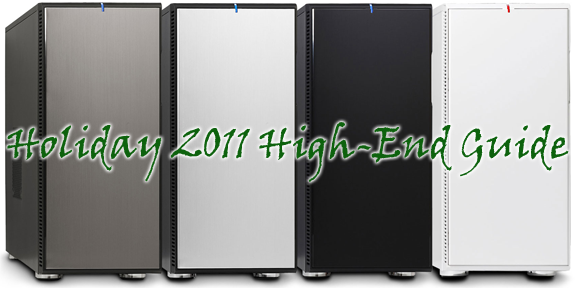Holiday 2011 Mainstream High-End Buyer's Guide
by Zach Throckmorton on December 9, 2011 12:00 AM EST- Posted in
- Guides
- AMD
- Intel
- Sandy Bridge
- CrossFire
- Sandy Bridge E
- Holiday 2011
- NVIDIA
Occasionally, I put together ridiculously expensive "dream" systems—computers worth as much as a car that feature multiple high-end CPUs, dozens of terabytes of storage, exotic cooling solutions, or enough GPUs to run flight simulators on five monitors at high framerates. These computers are a real treat to build, but they are not at all mainstream. While others have different ideas about what constitutes the upper end of the mainstream DIY PC market, generally speaking, $2000 represents a reasonable threshold. Past this point, returns for increased investment decrease very rapidly, such that they are justified only by niche use—or glorious indulgence.

In our recent midrange buyer's guide, I outlined three systems: a less expensive general use system capable of lighter gaming, a $1000 gaming box, and a $1200 work-oriented PC. In this guide, I detail three more systems, each around $2000 in cost. First up is a $1900 small form factor (SFF) home theater PC (HTPC). If it weren't for the anomalously high prices of hard drives at the moment (and for the near term future), this system would be much less expensive. However, high hard drive prices are a reality, and thus, this HTPC is now at the high end of mainstream PCs. Second, we have an $1800 gamer that is substantially more capable than the $1000 gamer in the midrange guide. Finally, because we eschew the fastest GPUs, we're able to bring you a productivity PC that features a higher-than-mainstream CPU—the less expensive of Intel's newest six-core Sandy Bridge-E chips.
In the midrange buyer's guide, I emphasized my confidence that those systems will likely remain enjoyable to use through 2016 for a number of reasons. The systems outlined in this guide are even more powerful. While I hesitate to speculate about the computing world past 2016, but I am confident that the three computers detailed in this guide will probably remain relatively capable for another five years—delivering more than acceptable and even enjoyable experiences. If you buy at the high end, there's probably a reason for it, so very likely you'll upgrade before five years have passed. Even so, with computer performance requirements leveling out, you can always sell a still-fast PC or give it to a friend/family member.
Perhaps the most important thing to keep in mind when designing and building a $2000 PC is to have fun and enjoy it! Any reasonable enthusiast would be more than happy to use any of the systems outlined in this guide. So without further ado, the next page starts with a system that packs a powerful CPU and lots of storage space into a small chassis.










52 Comments
View All Comments
Donkey2008 - Monday, December 12, 2011 - link
Where did you find this price? I have only found it at $200+. And why did you not look at the Antec HCP-850 PSU? It is equal to the Seasonic and costs $40 to $50 less.Just curious. I know Seasonic is the JIMP for computer geeks, but there are other companies marketing Seasonic products with their label slapped on them, including many of the top-tier Antec PSUs. I guess I do not understand why people seem willing to pay that $40 to $50 extra to get a little horse logo on their polo shir...I mean Seasonic label on their PSU. Just sayin.
Jungwirsch - Thursday, December 15, 2011 - link
When building a system with aspirations towards becoming a gamer's trusted companion for years to come, 1 TB of HDD space will most likely not cut it. Recent games (Skyrim a noted exception) routinely need 15-30 GB (Rage, SW Force Unleashed come in at the higher end), and this development will certainly continue. The size of the average game installation has increased approximately 1000-fold over the last 20 years. Personally, my Steam folder is pushing 700 GB.Rage really is a gaming engine with a game tucked on as an afterthought. The developers explicitly stated that they really had 150 GB of textures, but that just wasn't marketable for now. Guess what, eventually we will see games coming out with such oceans of eye candy data.
Hence, even with the recent jackup of prices in HDDs, I'd get the biggest I can. Even more so if using Steam client, because it more or less necessitates all the games from that one vendor to reside on the same drive.